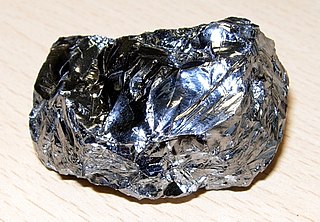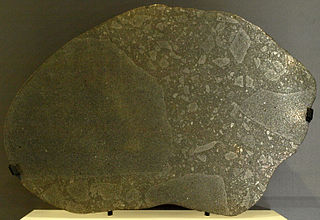
Silicon is a chemical element with the symbol Si and atomic number 14. It is a hard, brittle crystalline solid with a blue-grey metallic lustre, and is a tetravalent metalloid and semiconductor. It is a member of group 14 in the periodic table: carbon is above it; and germanium, tin, and lead are below it. It is relatively unreactive. Because of its high chemical affinity for oxygen, it was not until 1823 that Jöns Jakob Berzelius was first able to prepare it and characterize it in pure form. Its oxides form a family of anions known as silicates. Its melting and boiling points of 1414 °C and 3265 °C respectively are the second-highest among all the metalloids and nonmetals, being only surpassed by boron. Silicon is the eighth most common element in the universe by mass, but very rarely occurs as the pure element in the Earth's crust. It is most widely distributed in dusts, sands, planetoids, and planets as various forms of silicon dioxide (silica) or silicates. More than 90% of the Earth's crust is composed of silicate minerals, making silicon the second most abundant element in the Earth's crust after oxygen.

The pyroxenes (commonly abbreviated to Px) are a group of important rock-forming inosilicate minerals found in many igneous and metamorphic rocks. Pyroxenes have the general formula XY(Si,Al)2O6, where X represents calcium, sodium, iron (II) or magnesium and more rarely zinc, manganese or lithium, and Y represents ions of smaller size, such as chromium, aluminium, iron (III), magnesium, cobalt, manganese, scandium, titanium, vanadium or even iron (II). Although aluminium substitutes extensively for silicon in silicates such as feldspars and amphiboless, the substitution occurs only to a limited extent in most pyroxenes. They share a common structure consisting of single chains of silica tetrahedra. Pyroxenes that crystallize in the monoclinic system are known as clinopyroxenes and those that crystallize in the orthorhombic system are known as orthopyroxenes.
Silane is an inorganic compound with chemical formula, SiH4, making it a group 14 hydride. It is a colourless, pyrophoric, toxic gas with a sharp, repulsive smell, somewhat similar to that of acetic acid. Silane is of practical interest as a precursor to elemental silicon.
Hapkeite is a mineral discovered in the Dhofar 280 meteorite found in 2000 in Oman on the Arabian peninsula. The meteorite is believed to originate from the Moon; specifically, it appears to be a fragment of lunar highland breccia. Hapkeite's composition is of silicon and iron, and it is similar to other silicon-iron minerals found on Earth. An impact on the Moon is thought to have launched the partially molten or vaporized material into orbit.

Magnesium silicide, Mg2Si, is an inorganic compound consisting of magnesium and silicon. As-grown Mg2Si usually forms black crystals; they are semiconductors with n-type conductivity and have potential applications in thermoelectric generators.
A silicide is a compound that has silicon with (usually) more electropositive elements.

Platinum silicide, also known as platinum monosilicide, is the inorganic compound with the formula PtSi. It is a semiconductor that turns into a superconductor when cooled to 0.8 K.

Ferrosilicon is an alloy of iron and silicon with an average silicon content between 15 and 90 weight percent. It contains a high proportion of iron silicides.
Xifengite (Fe5Si3) is a rare metallic iron silicide mineral. The crystal system of xifengite is hexagonal. It has a specific gravity of 6.45 and a Mohs hardness of 5.5. It occurs as steel gray inclusions within other meteorite derived nickel iron mineral phases.

Calcium disilicide (CaSi2) is an inorganic compound, a silicide of calcium. It is a whitish or dark grey to black solid matter with melting point 1033 °C. It is insoluble in water, but may decompose when subjected to moisture, evolving hydrogen and producing calcium hydroxide. Decomposes in hot water. It is flammable and may ignite spontaneously in air.
Copper silicide (Cu5Si), also called pentacopper silicide, is a binary compound of silicon with copper. It is an intermetallic compound, meaning that it has properties intermediate between an ionic compound and an alloy. This solid crystalline material is a silvery solid that is insoluble in water. It forms upon heating mixtures of copper and silicon.

Enstatite chondrites are a rare form of meteorite thought to comprise only about 2% of the chondrites that fall on Earth. Only about 200 E-Type chondrites are currently known.
Suessite is a rare iron silicide mineral with chemical formula: Fe3Si. The mineral was named after Professor Hans E. Suess. It was discovered in 1982 during the chemical analysis of The North Haig olivine pigeonite achondrite (ureilite). It is a cream white color in reflected light, and ranges in size from 1 μm "blebs" to elongated grains that can reach up to 0.45 cm in length. This mineral belongs in the isometric crystal class. The isometric class has crystallographic axes that are all the same length and each of the three axes perpendicular to the other two. It is isotropic, has a structural type of DO3 and a crystal lattice of BiF3.

Binary compounds of silicon are binary chemical compounds containing silicon and one other chemical element. Technically the term silicide is reserved for any compounds containing silicon bonded to a more electropositive element. Binary silicon compounds can be grouped into several classes. Saltlike silicides are formed with the electropositive s-block metals. Covalent silicides and silicon compounds occur with hydrogen and the elements in groups 10 to 17.

Nickel silicides include several intermetallic compounds of nickel and silicon. Nickel silicides are important in microelectronics as they form at junctions of nickel and silicon. Additionally thin layers of nickel silicides may have application in imparting surface resistance to nickel alloys.
Linzhiite is an iron silicide mineral with the formula FeSi2. It was discovered in the 1960s in Donetsk Oblast in Soviet Union, and named ferdisilicite, but was not approved by the International Mineralogical Association. It was later rediscovered near Lnzhi in Tibet. Linzhiite occurs together with other rare iron silicide minerals, xifengite (Fe5Si3) and naquite (FeSi).
Naquite is an iron silicide mineral with the formula FeSi. It was discovered in the 1960s in Donetsk Oblast in Soviet Union, and named fersilicite, but was not approved by the International Mineralogical Association. It was later rediscovered in Nagqu, Tibet. Naquite occurs together with other rare iron silicide minerals, xifengite (Fe5Si3) and linzhiite (FeSi2).
Diiron silicide (Fe2Si) is an intermetallic compound, a silicide of iron. It occurs in cosmic dust as the mineral hapkeite. It is a non-stoichiometric compound where the Fe:Si ratio depends on the sample preparation. A related compound Fe5Si3 occurs in nature as the mineral xifengite.
Iron disilicide (FeSi2) is an intermetallic compound, a silicide of iron that occurs in nature as the rare mineral linzhiite. At room temperature it forms orthorhombic crystals (β phase), which convert into a tetragonal α phase upon heating to 970 °C.

Iron monosilicide (FeSi) is an intermetallic compound, a silicide of iron that occurs in nature as the rare mineral naquite. It is a semiconductor with unusual magnetic properties at low temperatures. It has a cubic crystal lattice with no inversion center; therefore its magnetic structure is helical, with right-hand and left-handed chiralities.







